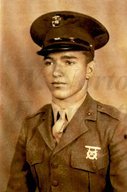
|

|
|
|
|
Placed as an infant in what he calls "a home for unwanted children," Milton was three months old when Roy Alford Saxon and Mary Gladys Birch Saxon adopted him. The couple would have one daughter. Milton's mother died when he was fourteen. His father re-married a woman with three children. The couple had three more children together. "So our family was kind of a mixed-up confused situation," he says. The Saxons moved to the Rio Grande Valley where Milton grew up, mainly in McAllen, while his father worked for Southwestern Bell Telephone Company. Milton dropped out of high school in his senior year in March 1944 and joined the U.S. Marine Corps when he turned eighteen. After boot camp he was assigned to 60-mm mortars, and sent to Hawaii where he began eighteen months of training as part of Company K, 3rd Battalion, 25th Regiment, 4th Marine Infantry Division. In the early morning of February 19, 1945, he made the morning assault on Iwo Jima in the fifth wave, watching all corporals and squad leaders in his platoon killed or wounded. Milton, a private first class, says that he was one of three who weren't "wounded or killed in our group." Running across the beach, Milton and his best friend, Eddie Hudspeth, made it to tall sand dunes of black volcanic ash. The ground in front of him was a "big, flat area with nothing for protection except bomb craters," he recalls. "The only protection that we had was to dive in the bomb craters." Running from one crater to another, walking when he was too exhausted, he made it to his assigned area "under the bluffs on the big end of the island." He dug his foxhole to sit with his back to the bluff to avoid fire from Japanese on the high ground. He and Hudspeth shared a foxhole and alternated two-hour sleep and two-hour awake cycles. "I started the Lord's Prayer but I never finished it. I remember starting it but from sheer exhaustion fell asleep," he recalls. That first day began twenty-seven days of nearly constant combat, in which he quickly learned the importance of foxholes. "If you could get an eighth of an inch below grand level you were safe, he says. The top of his mortar, which was two feet tall, had to be below ground level. "You're sitting as low as possible with only your eyes working," he says. They fired the mortar all night long. Meanwhile, naval F4U Corsairs dropped napalm bombs while F6F Hellcats strafed Japanese positions. After the first day, the Marines advanced farther inland to an area (later known as "The Meat Grinder") where the enemy was dug in about "fourteen miles" of tunnels, caves, pillboxes, and tanks half-buried--all with interlocking fire. Milton usually worked with his mortar about one hundred yards behind the front-line Marines. "We were continually firing, and continually under fire," he says. Each day, he says, they might advance forty or fifty yards. "Two or three days we may not move at all. As soon as we moved we had to be busy digging our hole again." His clothes became so ragged and rotten he pinned pieces together with safety pins. He was not able to take a bath during those twenty-seven days of combat. He received no mail, and ate only cold K rations. He was one of three in a platoon of thirty not wounded or killed. "I didn't do anything that was foolish. I did everything I knew to do to stay alive," he says. African-American marines, he recalls, had dangerous jobs. Although they were stationed back at the beaches, they were unloading ammunition. The Japanese often shelled that area. Milton recalls the flag-raising incident on Mount Surabachi. Although he was a mile away and did not witness it, he heard ships blowing whistles and horns, then learned of the event. On his twenty-seventh day of combat, he recalls, his unit was suddenly relieved, sent back to the beach, and taken out to an APA. Soon after boarding they were given showers and issued new fatigues. He arrived on Maui on Easter Sunday, April 1, and began what he recalls as a difficult time to adjust to a life without combat. Meanwhile, he began training for the invasion of Japan. "Relieved," is how he says he felt when he heard Japan had surrendered. Although he volunteered to go to the occupation in Japan, he was placed in a purchasing and disbursing office at Pearl Harbor. He returned to the States in April of 1946 and was discharged in San Diego. Back home, he entered summer school, then enrolled at Southern Methodist University in the fall, although he did not have a high school diploma. The next semester, he transferred to Texas A&I in Kingsville, where he earned a bachelor of science in secondary education in 1950. (He would earn a master's degree in school administration in 1958.) On September 29, 1949 he married Darlette Jean McCain. (They would have four children, four grandchildren, and one great-grandchild.) Milton began coaching and teaching at a high school in Banquete, Texas, a farming community between Corpus Christi and Laredo. He became school superintendent at San Perlita near Raymondville. Milton was fifty-seven years old before he learned he was adopted. When a cousin revealed the information he learned that his birth mother was a ballerina. After Milton retired he lived in Longview, Texas. |


